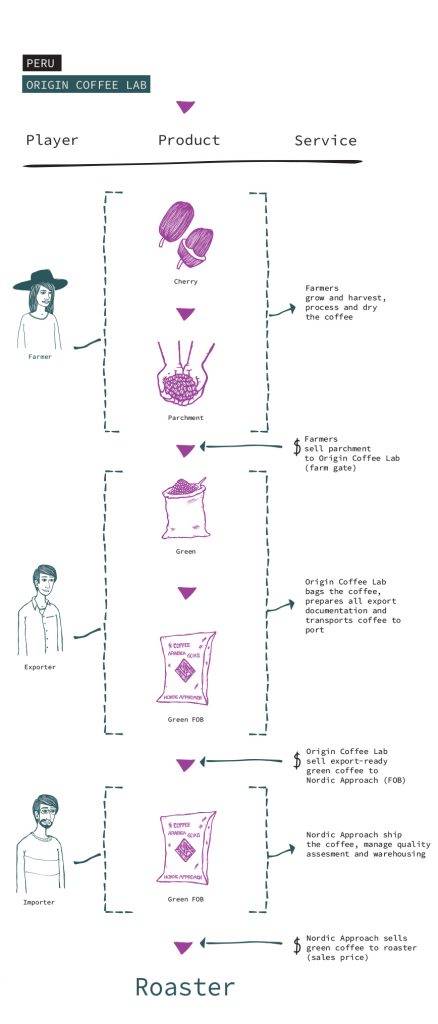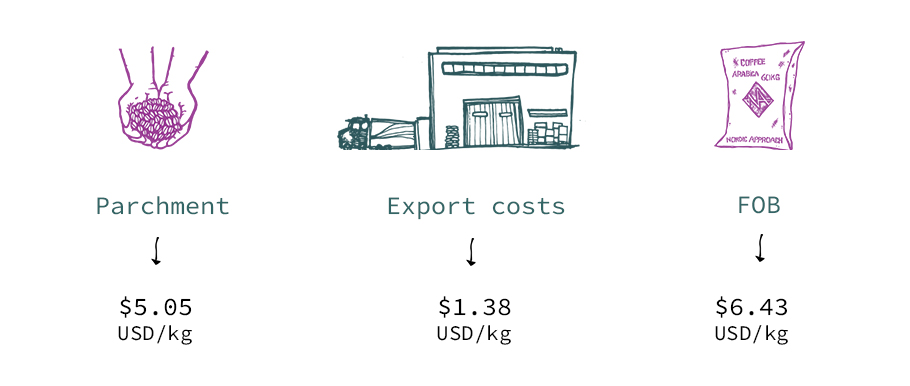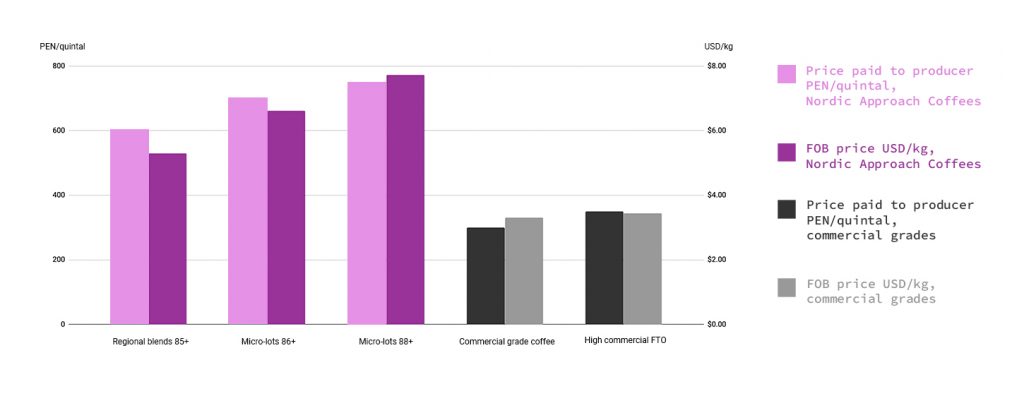How we work in this origin
We are amazed by the potential in Peru. With simple equipment and minimal infrastructure or support from the government, farmers can produce outstanding coffees. Sadly most of these quality lots go into a big pile which is sold for an extremely low price. Producers are generally paid for a certification, and not for quality, so they don’t invest in improving quality. Fortunately things are changing.
We incentivise quality in this origin by creating quality programs in small communities, building protocols, and paying solid premiums to our producers.

The Peru value chain
Before digging into this financial data, it is essential to understand the value chain in Peru. For an overview of the value chain, and how it provides context to farm gate prices, read our primer What You Need To Know About the Value Chain.
Farmers in Peru are typically smallholders with around 2-5 hectares of farmland. Coffees are usually processed in small micro mills on the farm. Farmers deliver parchment to exporters or cooperatives who cup and grade the coffee, dry mill and export green coffee.

Our value chain in Peru
We work in the north of Peru around Jaen and San Ignacio in Cajamarca where we have established a quality program with small producing communities in partnership with local export company, Origin Coffee Lab. We are also building a program with small quality-focused cooperatives, beginning with Cedros.
We select micro-lots of the high performing coffees at lot sizes between 10 – 20 bags. Additionally we create blends from the same communities where the coffees are exceptional, but the lots may be too small to buy individually. We pay high premiums for quality, well above the local price.

What you need to know about this price data
Farmer delivers: Parchment
Unit of Measurement: Quintal (55.2kg of parchment)
Currency: Sol (PEN)
Average cost of production: 320 – 400 PEN/quintal*
If the coffee meets our quality standards on humidity and has a minimum score of 85, we pay a base price of 500-600 PEN per quintal. The price depends on the program and commitment of the producer.
If the coffee cups above 87, and there is sufficient volume for a micro-lot, we pay an additional 100-150 PEN per quintal after the coffee has been contracted and exported.
*Source: Average cost of production reported by Origin Coffee Lab and Eleva Finca
Prices and costs for Nordic Approach coffees purchased in 2019
Average prices and costs for coffees purchased by Nordic Approach in 2019, equivalent to USD/kg exportable green.
See how we calculated these costs and prices
Farm gate and FOB by coffee lot
Follow the links to each coffee’s profile on Cropster Hub to see what the farmer earned, and the FOB price we paid for this coffee.
PE-2019-005 Flor de Selva (Organic)
PE-2019-008 Estrella Divina (Organic)
PE-2019-022 El Mirador by Yoel Samaniego Rojas
PE-2019-026 La Lima by Eduardo Campos
PE-2019-029 El Lechero by Idelo Ulises Nayra Armijos
PE-2019-030 Las Quebradas
PE-2019-034 El Aserio by Jhonny Saavedra Abad
PE-2019-040 La Higuera #2 by Segundo Mondragon
PE-2019-041 La Higuera #3 by Segundo Mondragon
PE-2019-043 Vencedor by Welser Guerrero
PE-2019-045 Maria Esmilda Alverca Espinosa
Translate individual lot prices from PEN/quintal to USD/kg
Local market comparison
How prices for Nordic Approach coffees compare to the local market averages, 2019.
Data source: Local market prices reported by Origin Coffee Lab and Eleva Finca
Understanding parchment to green yield factors
In Peru this term describes the percentage of the delivered parchment weight that was converted into exportable green coffee after milling. If the parchment delivered has a lot of defective beans, stones, sticks or other contaminants, this weight will be lost when the coffee is milled and converted into green.
The yield of the coffee is determined during the milling process, and farmers who have a high yield, meaning more green coffee was extracted from the parchment, will earn a higher premium. Farmers who have a low yield, meaning less green coffee was extracted after milling because more parchment, defects and contaminants were present, will earn slightly less.
The average yield for specialty coffee with our partners is 75% and we recommend using this metric if you are converting these figures to USD per pound or kilogram of green. This means that the farmer usually delivers 100kg of parchment, of which the exporter is left with 75kg of exportable green after milling.
Transparency at Nordic Approach
This is our second origin transparency overview. You can read our other overviews here.
These origin overviews are a part of our ongoing commitment to display price transparency data from origin. They are the culmination of enormous effort from the Nordic Approach team to source accurate data from origin, plus countless hours of discussion and thought on the best way to present this data.
If you have thoughts on this report, or our transparency reporting in general, we would love to hear from you. Email Suzie to start the conversation.



